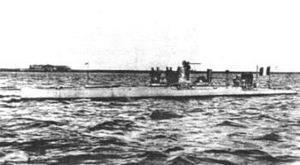Narval (Q 4)
| Narval (Q 4) |
|
|---|---|

|
|
| General data | |
| Ship type : | Submarine |
| Navy : | French Navy |
| Commissioning: | 1900 |
| Whereabouts: | 1909 canceled |
| Technical specifications | |
| Crew: | 13 men |
| Displacement : |
|
| Length: | 34 m |
| Width: | 3.8 m |
| Drive : |
|
| Speed : | |
| Driving range: |
|
| Armament | |
| Torpedoes : | 4 × 450 mm Drzewiecki drop collars |
The Narval (Q 4) ( French : Narwal ) was the first submarine in the French Navy with a hybrid drive consisting of an electric and a combustion engine .
Details
Although the Morse (Q 3) was still under construction, the new French Minister of War, Édouard Locroy, announced a competition for a new submarine in 1896. The tender called for a 200 ts displacement submarine that should travel 100 nautical miles over water and 10 nautical miles submerged. The construction developed by Maxime Laubeuf (also Laubœuf) was able to prevail against 28 competitors and was commissioned. The Narval (Q 4) entered service in 1900.
Compared to its predecessors Gymnote (Q 1) , Gustave Zédé (Q 2) and Morse (Q 3), the submarine had two revolutionary innovations:
- In addition to a lead-acid battery-powered electric motor for diving, a steam engine was used for the overwater march and to charge the batteries. The purely electrically powered predecessors of the Narval were referred to by the French Navy as Sousmarines (submarines). Apart from nuclear submarines , modern submarines, including the latest air-independent designs, still use the Narval's combined propulsion concept to this day . The French Navy called such submarines with a hybrid drive consisting of an electric motor and a combustion engine as submersibles (diving boats). The Irish-born American John Philip Holland was developing submarines for the US Navy at the same time , which were also equipped with a combined drive.
- For the first time a two-hull hull was used. The fuel tanks and the diving cells were located between the outer and inner shell. The two-hull concept developed by Labeuf was the basis of most submarine designs worldwide until after the Second World War . To this day, several modern Russian classes of submarines are double-hulled.
Due to the design, the submersion process was complicated, lengthy and even dangerous. The dive boat took up to 15 minutes to descend. The burner of the steam boiler had to be extinguished, the chimney had to be folded down and the flue gas outlet had to be sealed pressure-tight. The elaborate pressure-tight design of the exhaust system posed an enormous technological challenge and turned out to be unreliable. This problem was a serious flaw in the construction, as a water ingress via the large exhaust duct would have led to a total loss of the crew and the boat while diving. Although the Narval's propulsion concept was revolutionary and forward-looking, it also proved beyond doubt that conventional steam piston engines are unsuitable for use in submarines. Subsequent attempts by the British from 1917 to 1919 with the steam turbine -driven K class demanded as a result of serious accidents over a hundred lives English sailors. Only since the introduction of nuclear pressurized water reactors in the 1950s has the principle of steam propulsion been used again on submarines.
Four 450 mm torpedoes served as armament . Instead of torpedo tubes , drainage frames attached to the outside of the fuselage were used. This construction, which can be swiveled for aiming, is also known as the Drzewiecki drop collar after its Russian inventor .
As a result of the Faschoda crisis , which brought France and Great Britain to the brink of war, France built further submarines, some of which were financed through the nationalistically heated public through voluntary private donations. The result of the following building program were the four submarines of the Sirène , the four submarines of the Farfadet and the two submarines of the Morse class based on the Narval . By 1904, the French Navy had over 10 combat-ready modern submarines and 20 years of operational experience, while all other large navies were at best with the introduction of their first experimental submarines. The serious technological and quantitative lead of the French in submarine construction was quickly made up for by the US Navy, the British Royal Navy and especially the German Imperial Navy until the outbreak of World War I in 1914 .
The Narval (Q 4) was deleted from the French fleet register in 1909.
See also
- List of French submarine classes
- List of ships named Narval
- K class - British steam powered submarine class
Web links
- History of the early submarines at www.uboatnet.de
- French submarines at www.battleships-cruisers.co.uk ( Engl. )
literature
- Robert Hutchinson: FIGHT UNDER WATER - Submarines from 1776 to the present day. Motorbuchverlag, Stuttgart, 1st edition 2006, ISBN 3-613-02585-X .
- Anthony Preston: The History of the Submarines. Karl Müller Verlag, Erlangen, German edition 1998, ISBN 3-86070-697-7 .